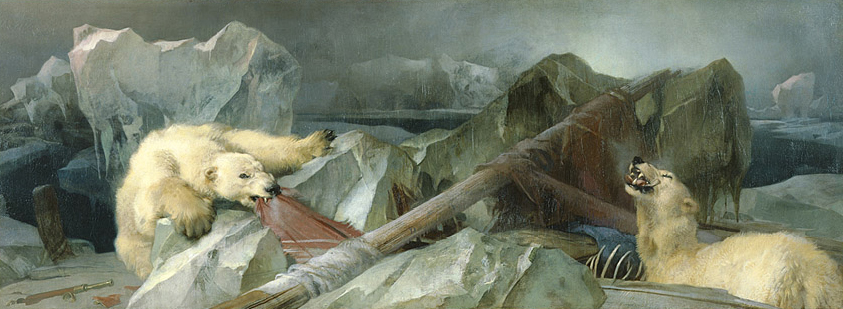This picture — unanimously regarded as Landseer's
grimmest and bleakest — references the famous failed attempt by the British explorer Sir John Franklin to find the
Northwest Passage. That expedition, which sailed in May of 1845, was both
well-equipped and highly touted, but it met with
complete disaster. After three years the British Admiralty sent out the first of several rescue attempts, and the remains and artifacts they found — and the fact more men died in the rescue efforts than died in the original expedition — helped fuel
ongoing public fascination with the entire affair. The
last rescue expedition was sent out in 1857, having been financed by public fundraising spearheaded by Franklin's widow, as the British navy had officially declared the entire crew of the expedition dead in 1854. This incident was the subject of numerous ballads, stories, and artworks such as Landseer's, which includes, in the lower left corner, a telescope, which was one of the earliest artifacts of the Franklin expedition found by a search team. Note also that just behind the ribcage — the polar bear on the right is chewing on a human rib bone — is what appears to be an article of blue clothing; the crew of Franklin's expedition would have been wearing blue jackets. The bear at left is tearing at a flag or ensign such as those that would have been used by British naval ships. Yet this is more than merely a comment on a specific incident; as the title indicates, this work may be saying something about human endeavor and
hubris -- a not uncommon topic for Victorian artists. (A possible influence on Landseer's painting are two works by the German painter Caspar David Friedrich:
Wreck in the Sea of Ice (1798) and
The Sea of Ice [1824].)
There's another context for this picture, however. It was painted in the immediate aftermath of the publication of Charles Darwin's
On the Origin of Species in 1859, which generated a firestorm of debate and argument, refutation and support. (Landseer is known to have taken about two years to paint this picture, which is a fairly short timeframe for Landseer at this point in his life, indicating he was
excited by this work.) Evolution and its related ideas immediately became a dominant and highly controversial topic in cultural and intellectual circles, and it's extremely likely Landseer was aware of this, as he moved in those circles and remained highly interested in current events throughout his life. Darwin's ideas of natural selection ("survival of the fittest") and the implications for humanity's self-perception regarding its place in the natural order of the universe may well have influenced this painting.

